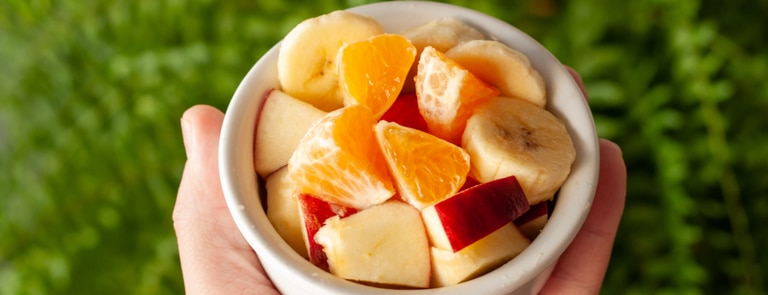How many portions of fruit and veg a day?

Wondering how many portions of fruit and veg we should eat a day? And how big the portion sizes are? We can help with that.
Government guidelines suggest we eat at least five, and up to 10 portions of fruits and vegetables per day.1 However, it can be difficult to know how to achieve this, and what a portion actually looks like.
One portion of fruit or vegetables is 80g.2
The table in this article shows how much of the food you’d have to eat to get one portion.
Some of them might surprise you, for example, you’d have to eat 20 raspberries to get your one portion, but only 1 slice of pineapple.3
In this article, you’ll find out:
- Why we need fruit and vegetables
- How much fruit and veg a day
- 5 a day portion sizes
- Smoothie inspiration
- Side effects of not getting enough in your diet
Why do our bodies need vegetables?
Fruit and vegetables are packed full of nutrients that help to keep our bodies healthy. In particular, vegetables are a great source of fibre that contribute to a healthy gut and prevent constipation.
In addition to this, lots of vegetables are a great source of vitamin C, folate and potassium.4
Why do our bodies need fruit?
Similarly, our bodies need fruit for the same reason.
They are a great source of fiber and vitamin C – eating fruit is a great way to naturally assist your immune system.5
Alongside this, fruits and vegetables provide the body with antioxidants which help to protect cells from oxidative stress caused by free radicals.6
Summary
- The main reason our bodies need fruit and veg is to ensure we get enough vitamins and minerals in our diet to keep us functioning healthily
How many portions of fruit and veg a day
So how many portions of fruit and veg should we aim for each day?
The NHS recommends that everyone should have at least five portions of fruit and vegetables everyday.4
And in order to get the maximum benefits, you should aim to eat different types of fruit and vegetables too.4
What is 5 a day?
The term gets thrown about a lot, but what is 5 a day?
Back in 2003, the government launched a 5-a-day campaign to help encourage the nation to get more fruit and veg into our diets.7
Since then, it has been a general aim for the public in order to help us lead healthy lives.
Summary
- As a rule of thumb, everyone should aim to eat five portions of fruit and veg each day

5 a day portion sizes chart
To help you get to grips with eating the right portion sizes of fruit and veg, we’ve compiled a handy chart full of adult and children fruit and vegetable portion sizes.
Fruit portion sizes
| Fruit | Adult portion size (80g) | Child portion size |
|---|---|---|
| Blueberries | 4 heaped tbsp | 2 heaped tbsp |
| Apple | 1 medium apple | 1/2 medium apple |
| Banana | 1 medium banana | 1/2 medium banana |
| Avocado | 1/2 standard avocado | 1/4 standard avocado |
| Fresh cherries | 14 cherries | 7 cherries |
| Grapes | 14 grapes | 7 grapes |
| Raspberries | 20 raspberries | 10 raspberries |
| Tomato puree | 1 heaped tbsp | 1 tsp |
| Strawberries | 7 strawberries | 4 strawberries |
| Pineapple | 1 large slice | 1/2 large slice |
| Blackberries | 9-10 blackberries | 5 blackberries |
| Fresh apricots | 3 apricots | 1 apricot |
| Fresh figs | 2 figs | 1 fig |
| Fruit juice (100% unsweetened) | 150ml glass | 150ml glass |
| Fresh/canned fruit salad | 3 heaped tbsp | 2 tbsp |
| Kiwi fruit | 2 kiwis | 1 kiwi |
| Lychees | 6 lychees | 3 lychees |
| Fresh mango | 2 slices | 1 slice |
Vegetable portion sizes
| Fruit | Adult portion size (80g) | Child portion size |
|---|---|---|
| Broccoli | 8 florets | 4 florets |
| Leeks | 1 medium leek (white portion) | 1/2 medium leek |
| Mushrooms | 8 mushrooms | 4 mushrooms |
| Pepper | 1/2 pepper | 1/4 pepper |
| Fresh spinach | 1 cereal bowl full | 1/2 cereal bowl full |
| Cooked spinach | 4 heaped tbsp | 2 heaped tbsp |
| Cucumber | 2 inch piece | 1 inch piece |
| Onion | 1 medium onion | 1/2 medium onion |
| Celery | 1 stick | 1/2 stick |
| Peas | 3 heaped tbsp | 1 1/2 tbsp |
| Sweet potato | 1 medium sweet potato | 1/2 medium sweet potato |
| Radishes | 10 radishes | 5 radishes |
| Carrots | 1 carrot | 1/2 carrot |
| Beetroot | 3baby whole/7 slices | 1 baby whole/3 slices |
| Cauliflower | 8 florets | 4 florets |
| Asparagus | 5 spears | 2 spears |
| Beans (any) | 3 heaped tbsp | 2 tbsp |
| Kale (cooked) | 4 heaped tbsp | 3 tbsp |

Side effects of not getting enough fruit and vegetables
If you’re not getting enough fruit and veg portions, you may experience some of these side effects:
- Constipation. As mentioned earlier in the article, a lack of fibre in your diet may lead to constipation.4
- Potential weight gain. Fruit and vegetables are generally lower in calories than other foods, so a lack of these foods could lead to a calorie surplus.4
- Scurvy. While this condition is rare, scurvy is caused by a lack of vitamin C – which is primarily found in fruit and vegetables.8
- Cardiovascular issues. Studies have shown that a higher daily intake of fruit and vegetables lowers the chance of developing cardiovascular disease.9
- Blood pressure. When examining the effect on blood pressure of a diet rich in fruits and vegetables, their systolic blood pressure was significantly reduced – therefore, a lack of fruit and vegetables may keep blood pressure levels high.9
Can you eat too much fruit and vegetables?
Having digested all of the above, you might be wondering whether you can eat too much fruit and vegetables?
According to government advice in the Eat Well guide10, fruit and veg should make up 40% of the food we consume daily, so it’s recommended to stick to this suggestion.
However, the key is to always remain balanced and try not to eat too much of one specific type of fruit and veg, and aim to change it up each time instead.
The final say
- Fruit and vegetables are essential for keeping us healthy
- Everyone should aim for five different portions a day
- Green smoothies are a great way to get fruit and veg into your diet
- Not getting enough fruit and veg may lead to health complications such as constipation, weight gain, scurvy, cardiovascular issues and blood pressure issues